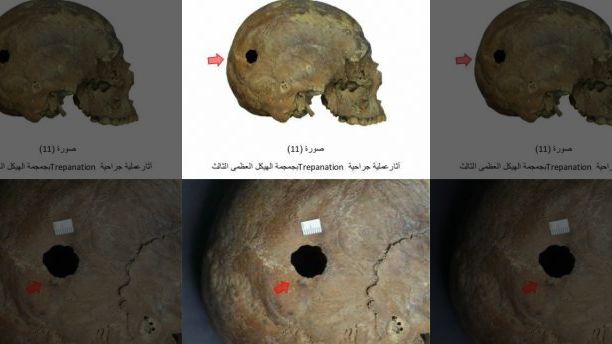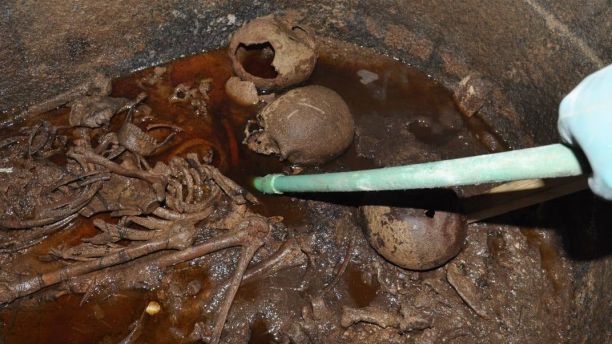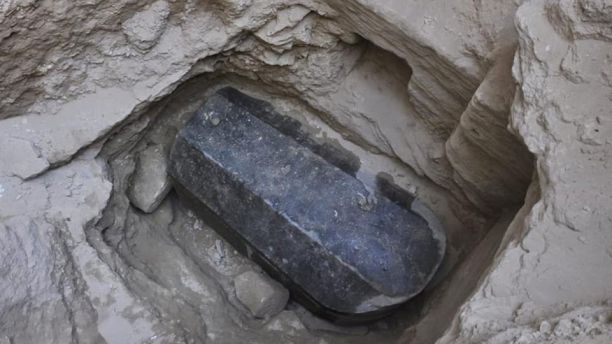‘Cursed’ ancient Egyptian sarcophagus “Mummy Juice” Secrets
Archaeologists in Egypt have unlocked the secrets of a mysterious ancient ‘cursed’ black granite sarcophagus. “A sarcophagus with this kind of weight and a lid that heavy is made for one reason! To keep whatever spirit in there from ever getting out. Leave the dead!”
The massive coffin, which was recently excavated in the city of Alexandria, was found to contain three skeletons and gold sheets with the remains. The tomb dates back to the Ptolemaic period between 305 B.C. and 30 B.C.
Measuring a whopping 9ft long, 5ft wide and 6ft tall, the casket, which was unearthed at a building site in Alexandria following a preliminary inspection by a team from Egypt’s antiquities ministry, dates back around 2,000 years and is the largest sarcophagus ever discovered in the city.
A sarcophagus (plural, sarcophagi) is a box-like funeral receptacle for a corpse, most commonly carved in stone, and usually displayed above ground, though it may also be buried. The word “sarcophagus” comes from the Greek sarx meaning “flesh”, and φαγεῖν phagein meaning “to eat”, hence sarcophagus means “flesh-eating”; from the phrase lithos sarkophagos . Since lithos is Greek for “stone”, lithos sarcophagos means “flesh-eating stone”. The word also came to refer to a particular kind of limestone that was thought to rapidly facilitate the decomposition of the flesh of corpses contained within it due to the chemical properties of the limestone itself
When archaeologists lifted its lid back in July, they discovered the remains of three skeletons that were partially submerged in a foul-smelling red liquid that was believed to be sewage. In a Facebook post Sunday, Egypt’s Ministry of Antiquities explained that preliminary studies had determined the gender and age of the skeletons. One skeleton belongs to a woman of 20 to 25 years of age, who was between 5-feet-3 and almost 5-feet-5. A second skeleton belonged to man between 35 and 39 years old, who was between 5-feet-3 and just over 5-feet-5. The third skeleton belonged to a man aged between 40 and 44, who was between 5-feet-10 and just over 6-feet tall.
Mystery surrounded the sarcophagus since its discovery was announced last month. The Independent, citing local reports, said that Egyptian officials had been mocking suggestions that opening the sarcophagus would unleash a curse.
Experts explained Sunday that a hole has been made in one of the skulls, the result of trepanation, or trepanning, a surgical procedure used to relieve pressure on the brain, that dates back thousands of years. The disgusting liquid they were found in was determined to be a combination of sewage that had leaked in to the coffin and the decomposing remains of the wrappings the bodies were buried in.
“This surgery is the oldest surgical intervention ever known since pre-history but was rare in Egypt,” said Dr. Zeinab Hashish, director of the department of skeleton remains studies at the Ministry of Antiquities.

Experts also explained the disgusting red liquid that was found inside the sarcophagus. Dr. Ayman Ashmawy, head of the ancient Egyptian antiquities sector, said that the liquid is likely sewage water combined with the decomposing remains of the skeletons’ wrappings.
While some historical accounts claim that the great Macedonian conqueror was ultimately buried in Alexandria following his death in 323 B.C., his tomb has never been found.
Two archaeologists who work in Alexandria and have knowledge of the discovery spoke independently to National Geographic. They both suspect that the sarcophagus itself may date to an earlier pharaonic dynasty in Egypt’s long history, due in part to its unusually large proportions.
One of the two archaeologists believes that, since Alexandria wasn’t even founded until the fourth century B.C., the massive sarcophagus may have been brought to the city empty, from an earlier, dynastic-period site down the Nile—such as Memphis—and then re-used to bury someone in later years.
The other archaeologist believes that the burial itself may also actually date to the Roman period, which follows the Ptolemaic period, based on its “high” elevation (the sarcophagus was uncovered just 15 feet below the modern street surface). This archaeologist also points out that the site of the burial is outside the boundaries of ancient Alexandria, making it highly unlikely that an ancient Egyptian royal would have been buried there.
More than 30,000 people signed a bizarre online petition asking to drink the red liquid. By drinking it, people claimed they would absorb the mummies’ powers.
More research will now be undertaken, including DNA tests and CT-scans, to find out more about the skeletons and determine whether they were related.

The sarcophagus was found buried 16.4 feet below the surface. A layer of mortar between the lid and the body of the sarcophagus indicated that it has not been opened since it was closed more than 2,000 years ago. A carved alabaster head, was also found, prompting speculation that it depicts the tomb’s owner.
The granite coffin’s contents offer the latest fascinating glimpse into the culture of ancient Egypt. Archaeologists, for example, recently found the oldest solid cheese in the tomb of Ptahmes, mayor of the ancient city of Memphis.
A mummy buried in Southern Egypt more than 5,000 years ago, has also revealed its grisly secrets, shedding new light on prehistoric embalming practices. Additionally, a mysterious sphinx, was discovered during roadwork in the Egyptian city of Luxor.
In a separate project, experts unearthed a 2,200-year-old gold coin depicting the ancient King Ptolemy III, an ancestor of the famed Cleopatra.
Experts in Southern Egypt recently discovered an extremely rare marble head depicting the Roman Emperor Marcus Aurelius. Other recent finds include an ancient cemetery in Egypt with more than 40 mummies and a necklace containing a “message from the afterlife.” An ancient statue of a Nubian king with an inscription written in Egyptian hieroglyphics was also found at a Nile River temple in Sudan.
Scientists also believe that they may have found the secret of the Great Pyramid’s near-perfect alignment. Experts are also confident that they have solved the long-standing mystery of the “screaming mummy.”
Source: Fox News



